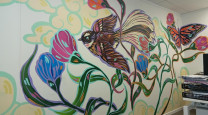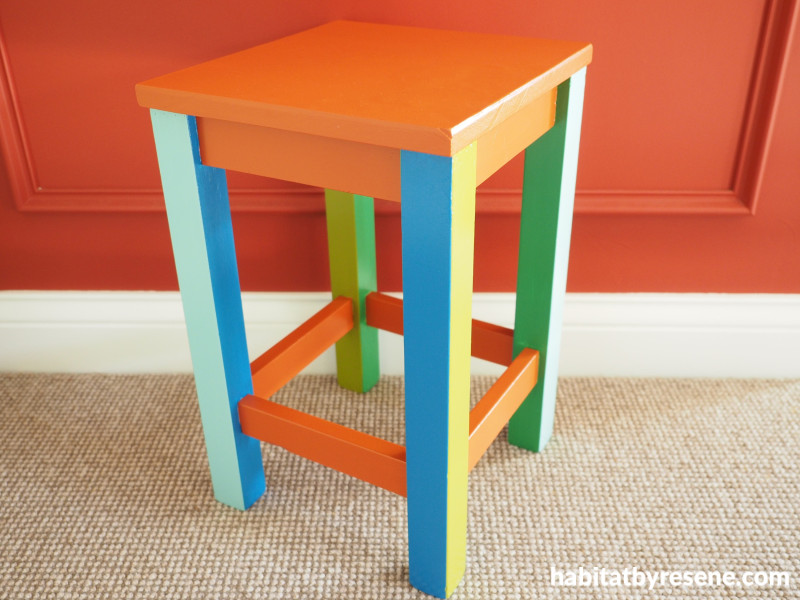
Two colourful DIYs to lift your winter mood
11 Aug 2025
Sometimes in winter things can feel a little… dull. Well luckily Resene has an abundance of bright and joyful paint colours that can brighten even the greyest of days! We’ve got two extra fun and vibrant DIY projects for you to try, both of which can be done in just a day. Head to your local Resene ColorShop to pick up your favourite Resene testpot colours today and let’s get painting!
Birdhouse rules: How to make and paint your own birdhouses
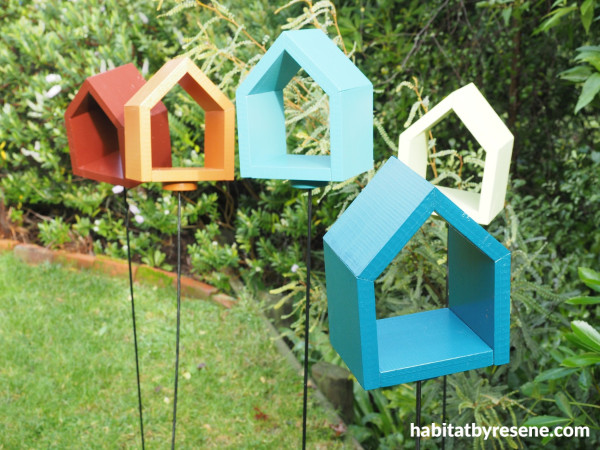
The great thing about these modern birdhouses is that you can sit and watch the birds inside them right from your cosy chair in the window. This simple design also means they are easy to make, so you can make one, or a whole lot in all of your favourite Resene testpot colours.
You will need:
- Treated pine wood, 900mm long x 140mm wide x 18mm thick
- Mitre saw
- Sandpaper
- Paintbrush
- Resene Quick Dry
- Paint
- Wood glue
- Electric drill
- Hole filler
- Jig saw
- Galvanised rod
- Resene Galvo-Prime
- Resene testpot in a colour of your choice
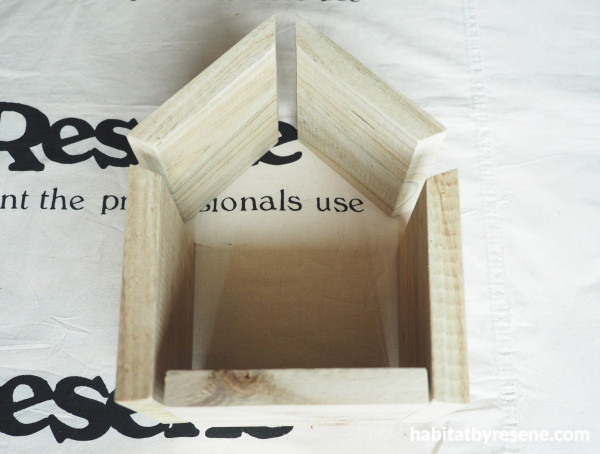
Step 1: Start by cutting all your wood to length. First cut the base to 15cm long. Cut two equal length pieces for the walls to 15cm long also. The bottom end of the walls needs a straight cut at 90 degrees, and the top end needs to be cut at 22.5 degrees where it meets the roof. Next, cut two equal length pieces for the roof that are 14cm long. The top join needs to be cut at 45 degrees, and the other end of the roof where it meets the top of the wall needs to be cut at 22.5 degrees.
Sand all the rough edges smooth, wipe away any sanding dust, and then prime all your pieces of wood with one coat of Resene Quick Dry. Once this is dry, paint with two coats of your chosen colour. Fleur used Resene Teal Blue for her birdhouse.
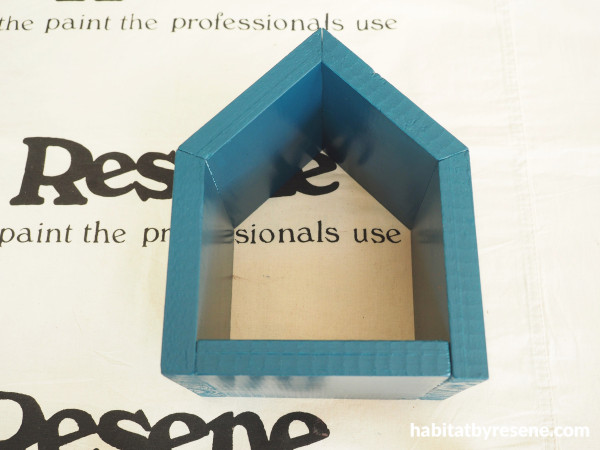
Step 2: Use exterior wood glue to glue your house together, and then secure with galvanised screws. Use some exterior hole filler to fill over the screw heads. Once this is dry, sand it smooth, wipe off any sanding dust, prime with Resene Quick Dry and then paint over with more of the same shade.

Step 3: Use a jig saw or band saw to cut a 7.5cm diameter circle out of some left over treated pine. Prime with Resene Quick Dry and paint this in more of the same paint colour. Drill a hole in it that is big enough to fit the galvanised rod, then glue and screw this to the underside of the base of the house.

Step 4: Prime the galvanised rod with a coat of Resene Galvo-Prime and then paint with two coats of your chosen Resene colour. Fleur used Resene Black for this. Insert the galvanised rod into the hole in the base. Push the rod into the garden so that the bird house stands up.
Tip: You might want to sprinkle some birdseed on the inside of your house to attract birds.
These bird houses are painted in (from left) Resene Volcano, Resene Alert Tan, Resene Ming, Resene Iko Iko and Resene Billabong.
Stool the show: How to refresh your old stool with paint
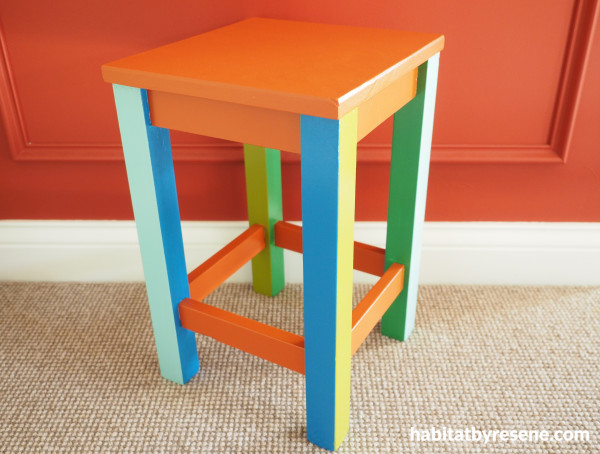
Most of us have old pieces of furniture lying around, often worn and tired looking, and screaming out for a new life. This painted stool shows just how much colour can change a piece of furniture and having it looking new again. And if you don’t have an old stool at home, we’re sure there might be a few sitting at your local Op Shop just waiting to be rescued.
You will need:
- Stool
- Sandpaper
- Paintbrush
- Resene Quick Dry
- Paint
- Painters tape
- Resene testpots in your chosen colours. Fleur used Resene Japanese Laurel, Resene Gulf Stream, Resene Captain Cook, Resene Grass Hopper and Resene Fire
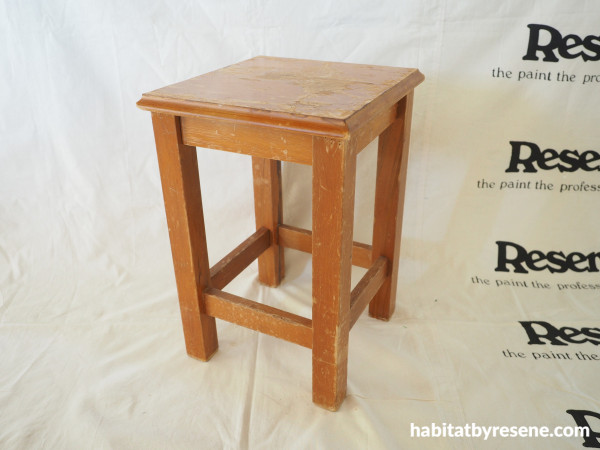
Step 1: Start by sanding your old stool with a medium grit sandpaper. Wipe away any dust and prime with one coat of Resene Quick Dry.
If the stool is varnished and the varnish is in good condition, you can skip the sanding and apply Resene Waterborne Sureseal to help the topcoats stick. This makes the project much faster and less messy than sanding.
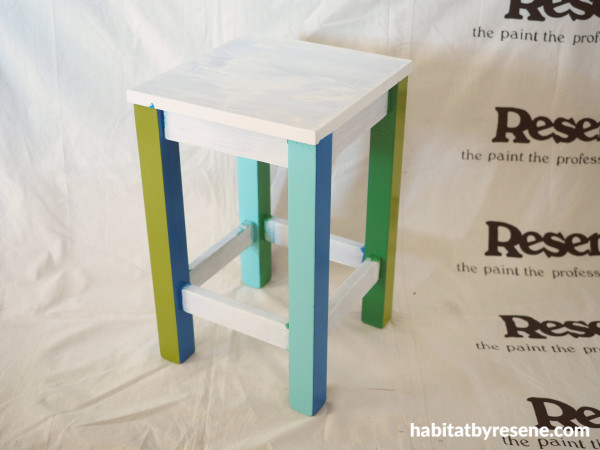
Step 2: Once the primer is dry, use four different coloured paints to paint each face of the legs. Fleur used Resene Japanese Laurel, Resene Gulf Stream, Resene Captain Cook and Resene Grass Hopper. Use painters tape on the corner of each leg to get a crisp line between your colours. Use Resene Lustacryl semi-gloss waterborne paint as this is more hardwearing or for a higher gloss use Resene Enamacryl.

Step 3: Finish by painting the cross bars and seat with two coats of another of your chosen colours. Fleur used Resene Fire for this step.
Wall painted in Resene Raging Bull and trims in Resene Rice Cake.
Top tip: Use the extra paint to paint a set of stools and a dining table to match.
projects and images Fleur Thorpe
Published: 11 Aug 2025


